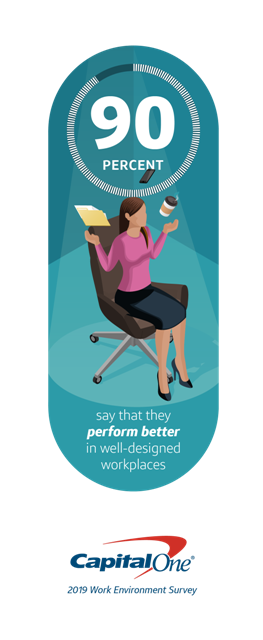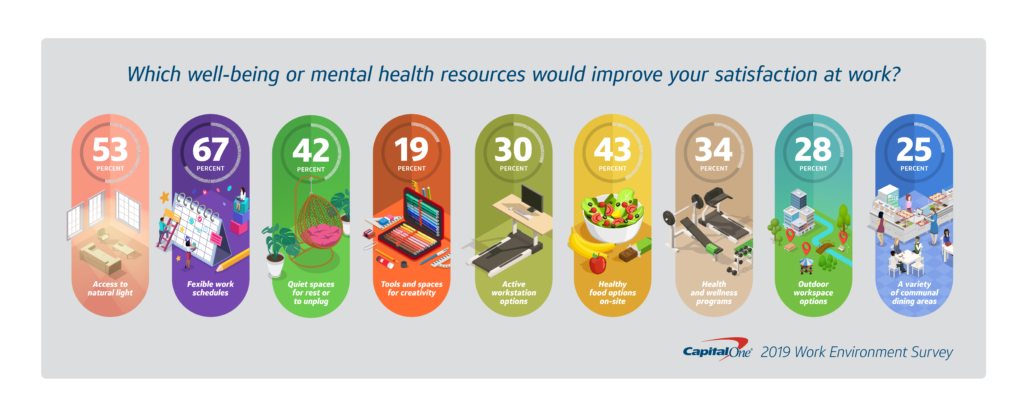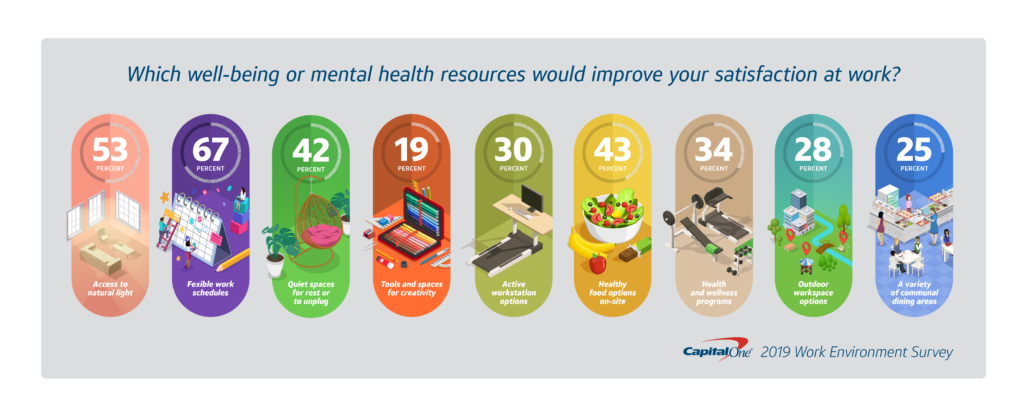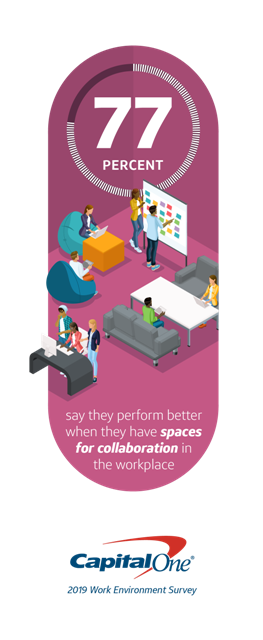Office design critical to employee success, reveals Capital One’s Work Environment Survey

by Eileen McMorrow
Good workplace design forms a base for success, according to the 2019 Capital One Workplace Environment Survey released July 30. This year’s data shows that thoughtfully designed office spaces are still top-of-mind for employees: Nearly all employees (90%) see that they perform better in well-designed workplaces. Further, employees continue to say that good workplace design drives them to be more innovative and productive. Millennials put an even stronger emphasis on well-designed workplaces with 35% agreeing strongly, compared to 32% of Boomers and 28% of Gen Xers.

The 2019 Capital One Workplace Environment Survey asked 3,500 full-time office professionals, 18 and over, to share their thoughts about the impact of workplace design and employee experience on their satisfaction, creativity and productivity at work. The responses are comprised of 1,000 nationwide + 2,500 combined designated markets (500 per market) for 3,500 total responses.
Flexibility and adaptability are critical elements of workplace design. Flexibility doesn’t just apply to design: employees’ highest priority is finding companies with flexible schedules and physical flexibility in the workplace. However, some shifts in year-over-year data suggest that employers need to remain adaptable and foster dynamic workplace design to accommodate employees’ changing preferences. Sixty-five percent say they are more productive when they change their physical location while working while 73% have their best ideas when they’re able to use flexible workspace options. Further, 73% are able to work better when they have access to flexible furniture arrangements such as different seated or standing options.
Most telling, 88% say they perform better when they have space for focused, heads-down work. And 45% say they would like to have space aside from their traditional workstation/desk for individual work.

For the second year in a row, a majority of employees say that workplace design is as important, if not more important than workplace location. More than half (54%) of employees say that workplace design is as important, if not more important than workplace location. The number jumps to 64% among mid-level employees.
Nearly one in five employees (19%) say that workplace design is more important than workplace location. Millennials feel even more strongly, with 24% saying workplace design is more important than workplace location.
“It used to be that Capital One was focused on its corporate real estate and facility management functions, but six years ago, Capital One Real Estate decided to be a service to its employees,” says Stefanie Spurlin, VP of Workplace Solutions, who discussed the survey findings in New York in late July. “We are moving to workplace and people vs. real estate/FM plus buildings.”

Capital One conducts the survey so it can improve its own facilities. “We want to retain employees and need to understand the role that workplace plays,” says Spurlin. “Space is not generational. There is a work type and personality types or differences to be considered. Recruitment and retention are important for older workers, Gen Z and Millennials.”
Employees (87%) expect companies to support their mental health and well-being. Millennials and Boomers feel even more strongly, with 44% and 41% respectively saying this is very important, compared to just 36% of Gen Xers.
Flexibility isn’t only important in workplace design. More than 2 in 3 (67%) employees say a flexible schedule is a resource in this area that would improve their satisfaction at work. Flexibility is key: 81% of employees rank a flexible schedule in their top two reasons to stay with a company, up 8% from last.

Office design plays a role in supporting mental health and well-being, too. Second to flexible schedules, over half of employees (53%) cite access to natural light as
a mental health resource that would improve their satisfaction at work.
42% would like to have quiet spaces in the office to unplug.
Connections to nature in the workplace can improve well-being. More than one third (36%) of employees say they have no connection to nature in their workplace, despite indicating that various types of connections (visual, physical or material) would improve their productivity and well-being. A visual connection to nature is sought by 57%–jumping to 62% among Boomers.
For Capital One, this is the second year collecting data at the national and regional levels, with the same sample sizes. Comparisons between 2018 and 2019 data refer to the 1,000 national respondents, and market-specific comparisons are between the same market’s responses or the full 2,500 sample. 2017 data is included with 2018 and 2019 data for reference of larger trends only.
